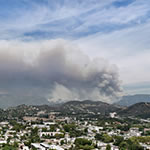The 1990s were a time of expansion in the United States, and Michele Steinberg has seen the effects of that expansion firsthand. “We saw a huge amount of population growth and development [in that period],” says Steinberg, who serves as the wildland fire projects manager at the National Fire Protection Association. “There was a very big push out into what was formerly agricultural, rural, wild land that hadn’t really been developed before, and it tends to be land where wildfire is part of the landscape.”
Today, there are more than 70,000 communities with a significant risk of wildfire. This emerging “wildland-urban interface” poses unique challenges for firefighters—and builders. Wildland firefighters are trained to contain a fire and may embrace a “let it burn” mentality knowing that fire is of benefit to the local ecosystem. This mentality does not always mesh with citizens who expect the fire department to spare no effort in saving their homes.
“Firefighters don’t have the resources to extinguish 100 homes,” Steinberg says. “The reality is that you’re not trying to keep your home from burning until the firefighters arrive—you’re trying to keep it from burning at all.” Here are steps homebuilders and owners can take to prevent wildfire damage.
1. Impede the fire, not the firefighters
All the necessary aspects of a property development can be optimized for wildfire damage mitigation. Roads should be wide enough to allow for emergency vehicles and can be designed to act as firebreaks. Whenever possible, there should be more than one point of access to a community. Since wildfires accelerate quickly up hills and canyons, the NFPA recommends houses be set back from hillsides. Burying utilities and power lines ensures that they will impede neither the safety nor mobility of firefighters on the scene.
2. Create functional firebreaks
Contrary to popular belief, wildfire prevention practices need not detract from the health or beauty of a community. “With some care and thought, you can live in an environmentally compatible fashion,” Steinberg says. While it may seem that naturally wooded areas should be left undisturbed, selectively clearing trees and underbrush enhances both property value and scenery. Steinberg notes that more wildlife will reveal itself, too, as birds, deer, and other grazers are drawn to edges where both sunlight and shelter are readily available. As part of the clearing process, trails and bike paths can be constructed to create additional firebreaks while promoting community health and wellness.
3. Opt for simple clean roofing
Property owners should start with the house and work outwards, according to the NFPA. A house’s roof is the dominant factor in ignition prevention. “In a severe wildfire, thousands of embers are hitting a home per second,” Steinberg says. Concrete tile and metal roofing are good options, but simple, composite asphalt shingles can be just as effective. Roofing materials and assemblies should have a Class-A rating from the American Society for Testing and Materials. Avoid complex or Spanish-tile roofs. These allow debris, which falling embers will ignite, to accumulate. Roofs should be regularly inspected for gaps or weaknesses, and gutters should be kept clean.
4. Reduce ignition through design
Besides posing a danger to the roof, embers can enter attics and crawlspaces through vents on the side of a building. One-eighth-inch mesh screening should be applied to minimize ember entry. Gable-end vents are especially vulnerable, so consider under-eave or soffit vents instead. The NFPA recommends tempered glass or double-paned windows—single-paned windows are more easily shattered by heat and falling debris. Firewise choices for siding include brick, stone, fiber-cement, and treated wood. “To a fire, whatever is attached to your house is part of your house,” Steinberg says. Consider ignition-resistance when adding a deck, porch, or fence to a property.
5. Pay attention to ‘ignition zone’
The NFPA has coined the term “home ignition zone” to include the home and its surrounding area within 200 feet. This area is a “defensible space” as long as potential fuel sources are limited. Lawns should be healthy, well-hydrated, and kept short. Alternatively, homeowners and homebuilders in drought-prone areas should consider xeriscaping to reduce both the risk of wildfire and their water footprint. Trees should have branches trimmed 10 feet from the ground and 30 feet apart from each other to prevent crowning. Trimmings and debris should be promptly removed from the property.
Learn more about wildfire prevention at firewise.org.

